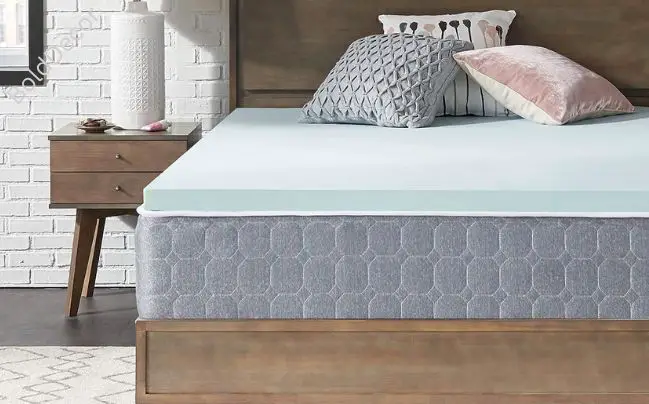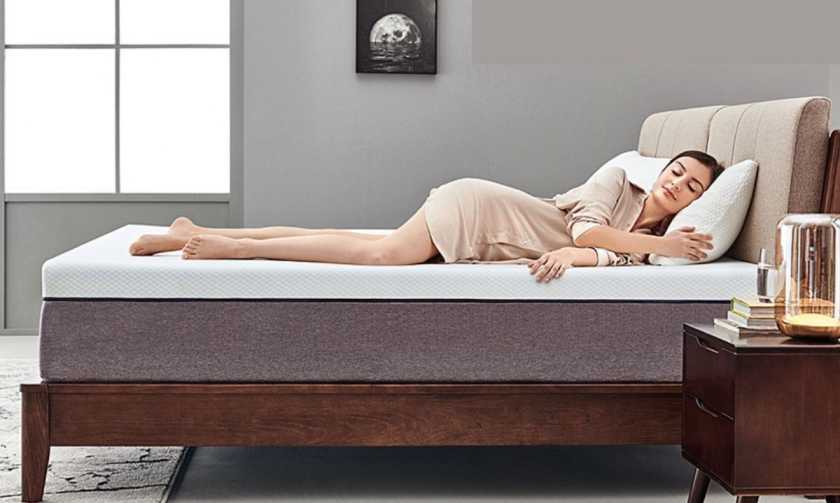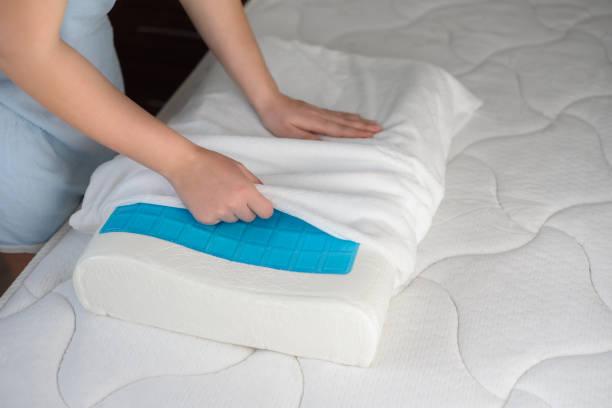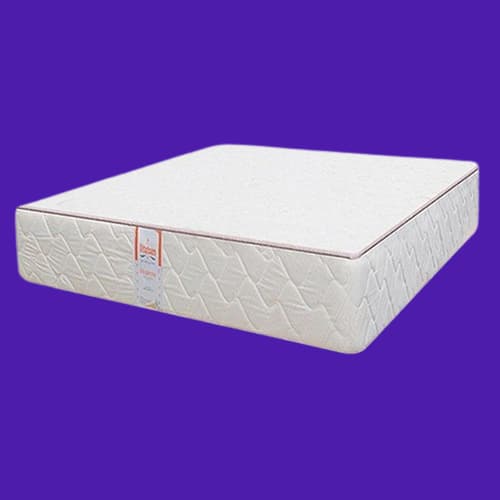As someone who loves their memory foam mattress, I know how important it is to properly care for it to ensure it lasts as long as possible. With a bit of effort and attention, you can keep your mattress in great condition and enjoy a comfortable night’s sleep for years to come. Here are some essential memory foam mattress maintenance tips that I recommend:
Key Takeaways
- Regular cleaning and protection is vital for maintaining a clean and hygienic sleep surface.
- Flipping and rotating your mattress regularly can help distribute weight and minimize sagging.
- Investing in a high-quality mattress protector can extend the life of your memory foam mattress.
- A proper foundation is essential for supporting your mattress correctly.
- Sometimes, it’s best to recognize when it’s time to replace your memory foam mattress.
Table of Contents
Regular Cleaning and Protecting Your Memory Foam Mattress
When it comes to memory foam mattress maintenance, cleaning and protection are key. A clean and hygienic sleep surface ensures a comfortable and healthy night’s rest. Here are some essential cleaning tips and protection techniques to keep your memory foam mattress in good condition for longer.
Cleaning a Memory Foam Mattress
Cleaning a memory foam mattress may seem like a daunting task, but with the proper instructions, it can be done quickly and easily. Here’s how to clean your mattress:
- Remove all bedding from the mattress and wash in the washing machine.
- Vacuum the surface of the mattress using a handheld vacuum or upholstery attachment to remove any debris or dust.
- Mix a solution of mild detergent and warm water in a spray bottle.
- Spray the solution onto the mattress surface, focusing on any visible stains or soiled areas.
- Using a clean cloth or sponge, gently rub the surface of the mattress in a circular motion to work the solution into the foam.
- Rinse the surface of the mattress with a clean, damp cloth, being careful not to over-wet the foam.
- Allow the mattress to air dry completely before replacing bedding.
Note: Avoid using harsh chemicals or solvents when cleaning your memory foam mattress, as they can damage the foam material.
Cleaning Hacks for Memory Foam Mattresses
In addition to the basic cleaning instructions, here are some helpful cleaning hacks to keep your memory foam mattress looking and smelling fresh:
- Spot-clean stains with a mixture of baking soda and water. Apply the paste to the stain and let it sit for 30 minutes before wiping away with a damp cloth.
- Absorb odors by sprinkling baking soda over the surface of the mattress and letting it sit for a few hours before vacuuming away.
- Use a handheld steam cleaner to deep-clean your memory foam mattress. The high-temperature steam sanitizes the surface without the need for harsh chemicals.
- Invest in a mattress protector to prevent spills, stains, and allergens from penetrating the surface of the mattress. A protector is much easier to clean and can help extend the life of your mattress.
By implementing these cleaning tips and techniques, you can maintain a clean and comfortable sleep surface on your memory foam mattress.
“A clean and hygienic sleep surface ensures a comfortable and healthy night’s rest.”
Flipping and Rotating Your Memory Foam Mattress
As mentioned earlier, memory foam mattresses are vulnerable to sagging, whereby some areas of the mattress become compressed from bearing more weight regularly. This can cause discomfort and reduce your quality of sleep. To prevent sagging and ensure even wear, it is essential to flip and rotate your mattress regularly.
While some brands claim to be one-sided, meaning they don’t require flipping, it’s still important to rotate them every few months to prevent uneven wear. By rotating your mattress, you ensure that both sides receive equal usage, preventing one side from becoming compressed more than the other.
| How often should you flip and rotate your memory foam mattress? | You should flip your mattress at least every six months and rotate it every three months. However, you can do it more frequently if you prefer. Set a reminder or mark your calendar to make sure you don’t forget. |
|---|---|
| How to flip and rotate your memory foam mattress | Remove all bedding and pillows from the mattress.Ask a friend or family member to help you flip and rotate the mattress to avoid injuring yourself and damaging the mattress.Flip the mattress by lifting one end and pulling it towards the other end. Then, lift the other end and bring it to the first end.To rotate the mattress, turn it 180 degrees, so the head end is now at the foot end, and the foot end is now at the head end.Make your bed with fresh bedding and pillows. |
Remember that flipping and rotating your mattress is as essential as cleaning it regularly. It may seem like a hassle, but it’s a small price to pay for keeping your mattress in good condition and extending its lifespan.
In the next section, we’ll discuss how to protect your memory foam mattress from spills and stains.
Protecting Your Memory Foam Mattress from Spills and Stains
Accidents happen, and spills and stains on your memory foam mattress can be a nightmare to deal with. Here are some tips on how to protect your mattress and keep it clean:
- Invest in a waterproof mattress protector to prevent spills and stains from seeping into your mattress.
- If a spill does occur, it’s essential to act quickly. Blot the affected area immediately with a clean, dry cloth. Avoid rubbing or scrubbing the stain, as this can push it deeper into the mattress.
- If the stain is particularly stubborn, mix a small amount of mild detergent with warm water and apply the solution to the affected area using a clean cloth. Blot with a dry cloth to remove excess moisture.
- To remove odors, sprinkle baking soda on the affected area and let it sit for several hours before vacuuming up the remaining powder.
- Regularly clean your mattress protector by washing it in cold water and drying it on a low heat setting. This will help prevent odors and bacteria buildup.
Remember, prevention is always better than cure when it comes to spills and stains on your memory foam mattress. By investing in a high-quality mattress protector and acting quickly when spills do occur, you can extend the life of your mattress and keep it looking and feeling great for years to come.
Maintaining a Good Foundation for Your Memory Foam Mattress
Choosing the right foundation for your memory foam mattress is essential for its longevity and proper support.
Best practices for memory foam mattress maintenance:
1. Always use a suitable foundation: A solid platform, box spring, or adjustable base are all excellent options. Avoid using old or damaged foundations that may affect the mattress’s support.
2. Ensure proper support: Make sure your foundation is sturdy and able to bear the weight of your mattress and body. Check for any signs of wear and tear, and replace your foundation if necessary.
3. Use a mattress protector: A mattress protector can help prevent damage to your mattress and extend its lifespan. It can also provide an additional layer of cushioning and support for your mattress, ensuring its longevity.
Table: Recommended Foundations for Memory Foam Mattresses:
| Foundation Type | Pros | Cons |
|---|---|---|
| Platform Bed | -Offers sturdy support for your mattress -Provides excellent ventilation and airflow to keep your mattress cool -Eliminates the need for a box spring or foundation | -May be difficult to move or adjust -Requires some assembly |
| Box Spring | -Provides even support for your mattress -Elevates your mattress to a comfortable height -Offers good ventilation and airflow to keep your mattress cool | -May be noisy or creaky -May wear out over time and require replacement |
| Adjustable Base | -Allows for customizable support and comfort -Provides relief for certain medical conditions and sleep disorders -Offers excellent elevation for people who prefer to sleep with their head or feet raised | -May be expensive -Requires a power source -May be heavy or difficult to move |
By following these best practices for memory foam mattress maintenance, you can ensure that your mattress has the support it needs to last for years to come.
Using a Mattress Protector
One of the best practices for memory foam mattress maintenance is investing in a mattress protector. A high-quality protector can help prolong the life of your mattress by protecting it from spills, stains, dust, and allergens.
Mattress protectors come in various materials, including cotton, polyester, and waterproof options. When choosing a protector, look for one that is breathable, hypoallergenic, and easy to clean. It should also fit snugly over your mattress without bunching or slipping.
Using a mattress protector is especially crucial if you have young children or pets. Accidents happen, and spills or stains can quickly damage your mattress. A protector can also prevent allergens and dust mites from accumulating, creating a healthier sleeping environment.
When it comes to cleaning your mattress protector, refer to the manufacturer’s instructions. Most protectors can be removed and washed in the machine. However, some may require hand washing or dry cleaning. Avoid using bleach or harsh detergents and always air dry the protector to prevent shrinkage or damage.
Dealing with Odors and Allergens
As part of best practices for memory foam mattress maintenance, it’s essential to address odors and allergens that can affect your sleep quality and health. Over time, your memory foam mattress can develop unpleasant odors or harbor allergens such as dust mites, pet dander, and mold. Here are some tips to help you eliminate odors and reduce allergens:
Give Your Mattress Some Fresh Air
One of the easiest and most effective ways to freshen up your memory foam mattress is to let it air out. Choose a sunny day and take your mattress outside to a well-ventilated area. Remove all bedding and allow the mattress to sit in the sun for a few hours. Sunlight and fresh air can help kill bacteria and odors naturally.
Vacuum Your Mattress
Regular vacuuming can help remove dust and allergens from your mattress. Use the upholstery attachment on your vacuum cleaner and run it over the entire surface of the mattress. Be sure to pay special attention to the seams and crevices where dust and debris can accumulate.
Use a Mattress Encasement
A mattress encasement is a protective cover that completely encases your mattress, providing a barrier against allergens and preventing them from penetrating the surface. Look for encasements that are specifically designed for memory foam mattresses and are breathable to allow for adequate airflow.
Deodorize with Baking Soda
Baking soda is a natural deodorizer that can help eliminate unpleasant odors from your mattress. Sprinkle a generous amount of baking soda over the entire surface of the mattress and let it sit for several hours. Then, use your vacuum cleaner’s upholstery attachment to remove the baking soda.
Consider a Professional Cleaning
If your memory foam mattress has deep-seated stains or odors that won’t go away, you may want to consider a professional cleaning service. Look for a company that specializes in cleaning memory foam mattresses and uses eco-friendly, non-toxic cleaning methods.
By following these memory foam mattress maintenance tips, you can ensure a clean and healthy sleep environment for years to come.
Recognizing When It’s Time to Replace Your Memory Foam Mattress
If you’ve been following the essential memory foam mattress maintenance tips discussed in this article, your mattress is likely to last for several years. However, there will come a time when you’ll need to replace it.
One of the most significant signs that it’s time to replace your memory foam mattress is when it no longer provides the support and comfort it once did. If you find yourself waking up with aches and pains or feeling like you’re sinking into your mattress, it’s a good indication that the mattress has lost its shape and needs replacing.
You should also consider replacing your memory foam mattress if it has lumps, indentations, or sagging areas. These can occur due to body weight, improper foundation or lack of proper maintenance. In some cases, a lump or sag may be a sign of a defect in the mattress.
If you or your partner tosses and turns a lot during the night, it can cause extra wear and tear on your mattress. This can lead to sagging or uneven wear, which can affect its support and comfort. If you notice these signs, it may be time for a new mattress.
Choosing a New Memory Foam Mattress
If you’ve recognized the signs that it’s time to replace your memory foam mattress, the next step is to choose a new one. When selecting a new mattress, consider your sleeping position, body weight, and any specific comfort or support needs you may have.
It’s also important to buy a mattress from a reputable manufacturer that offers a warranty or guarantee. This will give you peace of mind that you’re making a wise investment in your sleep.
Before making a purchase, test the mattress in a store or look for a company that offers a sleep trial period. This will allow you to try out the mattress for a few weeks or months and determine if it’s the right fit for you.
Replacing your memory foam mattress may seem like a daunting task, but following these tips will help you recognize when it’s time and choose a replacement that will provide the support and comfort you need for a good night’s sleep.
Bottom line
As I wrap up this article, I hope you’ve found these essential memory foam mattress maintenance tips helpful in extending the lifespan of your mattress. By implementing these best practices for memory foam mattress maintenance, you will ensure proper care for your memory foam mattress and enjoy continued comfort and support for years to come.
Regular cleaning, flipping and rotating, protecting your mattress from spills and stains, maintaining a good foundation, using a mattress protector, dealing with odors and allergens, and recognizing when it’s time to replace your mattress are all tips for extending the life of a memory foam mattress. By following these tips, you’ll not only protect your investment but also promote a healthy sleeping environment.
Remember, your memory foam mattress is an investment in your sleep and well-being. It’s essential to take care of it properly. By implementing these tips for extending the life of a memory foam mattress, you’ll be able to enjoy years of comfortable, restful sleep. Sweet dreams!
FAQ
What are some essential memory foam mattress maintenance tips?
To maintain your memory foam mattress, you should regularly clean and protect it, flip and rotate it, protect it from spills and stains, maintain a good foundation, use a mattress protector, deal with odors and allergens, and recognize when it’s time to replace it. Following these tips will help extend the lifespan of your mattress.
How do I clean a memory foam mattress?
To clean a memory foam mattress, start by vacuuming it to remove any loose debris. Then, spot clean any stains using a mixture of mild detergent and water. Afterward, rinse the area with clean water and allow it to air dry completely before adding bedding back on.
How often should I flip and rotate my memory foam mattress?
It is recommended to flip and rotate your memory foam mattress every 3 to 6 months. This helps distribute the weight evenly and prevents sagging in specific areas.
How can I protect my memory foam mattress from spills and stains?
To protect your memory foam mattress from spills and stains, it is advisable to use a mattress protector. It acts as a barrier between the mattress and any potential spills or accidents, making it easier to clean and maintain the mattress.
What kind of foundation should I use for my memory foam mattress?
It is recommended to use a solid, flat surface as a foundation for your memory foam mattress. This can include platforms, slatted bases with closely spaced slats, or adjustable bases specifically designed for use with foam mattresses.
Why should I use a mattress protector for my memory foam mattress?
Using a mattress protector helps protect your memory foam mattress from dust, allergens, spills, and stains. It acts as a barrier, keeping your mattress clean and hygienic, and can significantly extend its lifespan.
How do I eliminate odors from my memory foam mattress?
To eliminate odors from your memory foam mattress, you can sprinkle baking soda over the surface and let it sit for several hours before vacuuming it off. You can also air out the mattress in a well-ventilated area to help remove any lingering smells.
When should I replace my memory foam mattress?
It’s time to replace your memory foam mattress when you notice significant sagging, discomfort, or a decrease in support. Generally, memory foam mattresses last between 8 to 10 years, but individual factors such as usage and maintenance can affect their lifespan.






